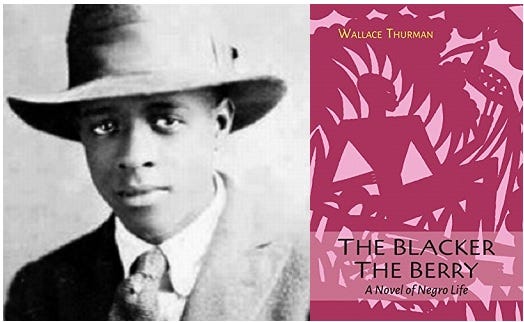
The Blacker the Berry: A Novel of Negro Life is a novel penned by African-American author Wallace Thurman during the Harlem Renaissance. The title is a phrase many recite as a term of endearment describing a handsome dark-skinned man or woman. In The Blacker the Berry: A Novel of Negro Life, Thurman tells the story of young, dark-skinned Emma Lou Morgan.
The story opens in Boise, Idaho, and follows Emma Lou throughout her journey as a student at University of Southern California and later relocation to Harlem. Set during the Harlem Renaissance, the novel explores Emma Lou’s experiences with color and discrimination by lighter-skinned African Americans. She learns to come to terms with her complexion in order to find satisfaction in her life.
Emma Lou lives in a world of scorn and shame, not because her skin is black, but because it’s too black. No one among her family, teachers, and friends has a word of consolation or hope for the despised and rejected girl. With nothing to lose, the 18-year-old leaves her home in Idaho, seeking love and acceptance on a journey that ultimately leads her to the legendary Harlem community.
Thurman re-creates this legendary time and place in rich detail, describing Emma Lou’s visits to nightclubs, dance halls, and rent parties; her sex life and catastrophic love affairs, her dreams and disillusions; and the momentous decision she makes in order to survive.
One of the most widely read and controversial works of the Harlem Renaissance, The Blacker the Berry was the first novel to openly explore interracial prejudice among Blacks. This pioneering work found a way beyond the bondage of blackness in American life to a new meaning in truth and beauty.
Throughout the novel, Emma Lou’s dark complexion is a source of sorrow and humiliation not only to herself, but to her lighter-skinned family and friends and to the white community of Boise, Idaho.
Thurman was born August 16, 1902, in Salt Lake City, Utah. He attended University of Southern California and University of Utah. Although initially interested in medicine, at USC, Thurman rediscovered an earlier enthusiasm for writing and literature. His journalism careers included columnist for a Black-oriented newspaper; creating the magazine, Outlet; then in New York City, where he settled in 1925, The Looking Glass; and managing editor of The Messenger, a socialist journal aimed at blacks.
Thurman started his own publication, Fire!!, a literary magazine conceived as a forum for young black writers and artists. Responses ranged from minimal notice in the white press to heated contention among African-American critics. Financial backing was unattainable; only one issue was ever published. Several hundred undistributed copies were destroyed when the building they were stored in burned to the ground.
Thurman died in New York City on December 22, 1934. By the time of his death at age 32 (tuberculosis), he had established himself as a pioneer and literary revolutionary who left an enviable written record as a legacy.